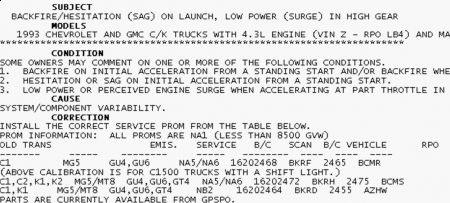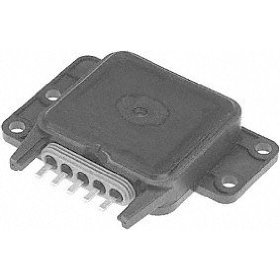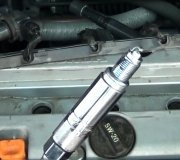Fuel Pressure Regulator (PFI) Fuel pressure regulator is a vacuum-controlled diaphragm type, which uses manifold vacuum to modify fuel pressure to compensate for engine load fuel requirements. Connect fuel pressure gauge to fuel pressure service port. 1Start engine and note fuel pressure. Disconnect vacuum hose from fuel pressure regulator. Fuel pressure should increase 4-10 psi (.28-.70 kg/cm 2 ). If 11pressure does not increase 4-10 psi (.28-.70 kg/cm 2 ), check for presence of 1manifold vacuum at signal line. If vacuum is not present, check for kinked, cut or split vacuum hose or plugged throttle body vacuum port. If vacuum is present and no pressure change occurs, replace fuel pressure regulator. Fuel Pressure Regulator (TBI) Fuel pressure regulator is mechanically controlled by internal spring pressure. Regulator is adjusted at factory and is not serviceable. If fuel pressure is too low, check for restricted delivery line. Also, check fuel pump pressure and volume. If fuel pressure is too high, check for restricted fuel tank return line or fuel filter. If no faults are found and pressure is too high or too low, replace fuel pressure regulator.
2/17/2010 .
FUEL SYSTEM PRESSURE TEST TBI 1. Turn ignition off for 10 seconds. Turn ignition on, and listen at fuel tank for fuel pump operation. Pump should run 2 seconds (20 seconds on models with fuel module). If fuel pump runs, go to next step. If fuel pump does not run, go to step 7). 2. If fuel pump runs, turn ignition off. Verify fuel tank has fuel. Relieve fuel pressure. See FUEL SYSTEM PRESSURE RELIEF. Remove air cleaner, and plug air cleaner vacuum ports (if equipped). Disconnect fuel line between throttle body and fuel filter. Install Fuel Pressure Gauge (J-29658A) and Adapter (J-2968A-85) between steel fuel line and flexible hose, ahead of in-line fuel filter. 3. Turn ignition on, and note reading on pressure gauge. If fuel pressure is 9-13 psi (.63-.91 kg/cm 2 ), no problems are present. If pressure is less than 9 psi (.63 kg/cm 2 ), go to step 5). If pressure is greater than 13 psi (.91 kg/cm 2 ), turn ignition off, and bleed fuel pressure. Disconnect fuel return line downstream of pressure gauge. Insert return line into a gasoline container. 4. Turn ignition on. If pressure is now 9-13 psi (.63-.91 kg/cm 2 ), correct restriction in fuel return line between disconnected point and fuel tank. If fuel pressure is greater than 13 psi (.91 kg/cm 2 ), check for restricted return line (including fuel filter) downstream of pressure gauge. If no restrictions are present, replace fuel pressure regulator (TBI 700) or fuel meter cover/pressure regulator (TBI 220). 5. Check for restricted line between in-tank fuel pump and pressure regulator. If fuel line is okay, disconnect injector connector. Turn ignition on. Gradually pinch fuel pressure gauge outlet hose. Note pressure. 6. If pressure is greater than 13 psi (.91 kg/cm 2 ), replace fuel pressure regulator (TBI 700) or fuel meter cover/pressure regulator (TBI 220). If pressure is less than 9 psi (.63 kg/cm 2 ), check for faulty fuel pump or incorrect part. Check fuel pump coupling hose and pump inlet filter in fuel tank. On models with dual fuel tanks, check for faulty fuel tank selector valve and meter switch. 7. Apply 12 volts to fuel pump test connector. For fuel pump test connector location, see underhood engine component views under COMPONENT LOCATIONS in SYSTEM/COMPONENT TESTS article in this section. If fuel pump now runs, repair open in fuel pump relay drive or power circuit or repair faulty fuel pump relay. To test relay, see SYSTEM/COMPONENT TESTS article in this section. 8. If fuel pump does not run with 12 volts applied to fuel pump test connector, repair open in fuel WARNING: Begin fuel system trouble shooting and diagnosis with fuel system pressure test. Relieve fuel system pressure before disconnecting any components or installing fuel pressure gauge. CAUTION: DO NOT pinch off fuel return line completely. DO NOT allow fuel pressure build-up to exceed specification, as damage to fuel pressure regulator may occur. Pump power or ground circuit, or repair faulty fuel pump.
(4.3L) 1. Relieve fuel pressure. See FUEL SYSTEM PRESSURE RELIEF. Connect Fuel Pressure Gauge (J-34730-1) to fuel pressure connector on fuel rail. Turn ignition on. With ignition on and engine off, pressure should be 54-64 psi (3.8-4.5 kg/cm 2 ) and should hold steadily. 2. If pressure is within specification and holds, go to next step. If pressure is within specification but does not hold, go to step 4). If no fuel pressure is present, go to step 7). If pressure is greater than specification, go to step 9). If pressure is less than specification, go to step 5). 3. Start engine. With engine at operating temperature, open throttle quickly and note fuel pressure. If pressure does not approach 64 psi (4.5 kg/cm 2 ), replace CPI assembly. If pressure approaches 64 psi (4.5 kg/cm 2 ), no problem is present. 4. Check for leaking injectors or fittings by pinching off fuel return line. If pressure does not hold, replace CPI assembly. If pressure holds, check for faulty in-tank fuel pump or pump connections. 5. Check for restricted delivery line or fuel filter. Repair as necessary. If no restriction is evident, apply battery voltage to fuel pump test connector using a 10-amp fused jumper wire. For location of fuel pump test connector, see COMPONENT LOCATIONS in SYSTEM/COMPONENT TESTS article in this section. 6. Gradually pinch off flexible fuel return line between CPI assembly and fuel tank. If fuel pressure increases to within specifications, pressure regulator is faulty. Replace CPI assembly. If fuel pressure does not increase with line pinched, check for faulty in-tank fuel pump, loose pump connections or partial blocked fuel strainer. 7. Use a 10-amp fused jumper wire to apply battery voltage to fuel pump test connector. For location of fuel pump test connector, see COMPONENT LOCATIONS in SYSTEM/COMPONENT TESTS article in this section. Observe fuel pressure reading. If fuel pressure is still not present, check wiring between test connector and fuel pump. If wiring is okay, replace fuel pump. 8. If fuel pressure is present with voltage applied to test connector, test fuel pump relay and voltage supply to relay. See SYSTEM/COMPONENT TESTS article in this section. 9. Relieve fuel pressure. Disconnect flexible fuel return line. Attach 5/16 ID flexible fuel line to CPI side of fuel line. Route hose into appropriate container. Turn ignition on, and note fuel pressure. If fuel pressure is within specification, locate and repair restriction in fuel return line. If fuel pressure is still greater than specification, replace CPI assembly.
(4.3L Turbo) 1. Relieve fuel pressure. See FUEL SYSTEM PRESSURE RELIEF. Connect Fuel Pressure Gauge (J-34730-1) to fuel pressure connector on fuel rail. Turn ignition on. With ignition on and engine off, pressure should be 35-38 psi (2.46-2.67 kg/cm 2 ). 2. If pressure is as specified, go to next step. If pressure is greater than specification, replace faulty pressure regulator. If pressure is less than specification, go to step 4). If no fuel pressure is present, go to step 6). 3. Start engine. Pressure should drop 3-10 psi (.21-.70 kg/cm 2 ). If pressure does not drop, replace faulty pressure regulator. If pressure drops, turn ignition off. Pressure should hold. If pressure does not hold, check for leaking injectors or fittings. If injectors or fittings are not leaking, replace pressure regulator. 4. Check for restricted delivery line or fuel filter. Repair as necessary. If no restriction is evident, apply battery voltage to fuel pump test connector using a 10-amp fused jumper wire. For location of fuel pump test connector, see COMPONENT LOCATIONS in SYSTEM/COMPONENT TESTS article in this section. 5. Gradually pinch off fuel delivery line between gauge and fuel rail. If fuel pressure increases to within specifications, replace fuel pressure regulator. If fuel pressure does not increase with line pinched, check for faulty in-tank fuel pump or partial blocked fuel strainer. 6. Use a 10-amp fused jumper wire to apply battery voltage to fuel pump test connector. For location of fuel pump test connector, see COMPONENT LOCATIONS in SYSTEM/COMPONENT TESTS article in this section. Observe fuel pressure reading. If fuel pressure is still not present, check wiring between test connector and fuel pump. If wiring is okay, replace fuel pump. 7. If fuel pressure is present with voltage applied to test connector, test fuel pump relay and voltage supply to relay. See SYSTEM/COMPONENT TESTS article in this section. Page 3 of 3 2/17/2010 .
SPONSORED LINKS
Was this helpful?
Yes
No
Wednesday, February 17th, 2010 AT 2:07 PM







